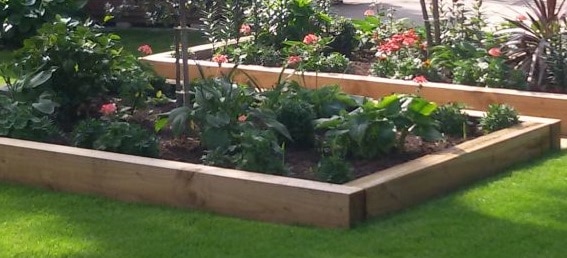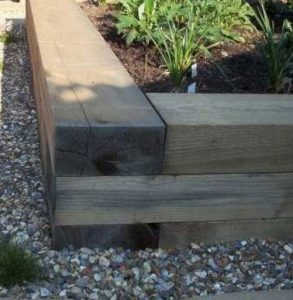No products in the cart.

Building a raised garden bed with railway sleepers is a quick, straightforward project that can significantly enhance your outdoor space. Whether you’re creating a dedicated vegetable patch or a raised flower bed, sleepers offer a sturdy and attractive solution. With just a few tools and a bit of planning, you can create a raised bed that is practical, long-lasting, and easy to maintain.

Why Choose a Raised Bed?
Raised beds offer multiple advantages:
- Improved drainage and soil quality
- Easier access for planting, weeding, and harvesting
- Extended growing season due to warmer soil
- Greater control over soil type and composition
They’re also perfect for gardeners of all ages and mobility levels, with customizable heights to suit standing, sitting, or wheelchair access.

Step-by-Step Guide to Building a Sleeper Raised Bed
- Choose the Right Location
Select a spot with plenty of sunlight, as light is crucial for both plants and vegetables. Consider ease of access:
- If you want to reach from all sides, aim for a width of 1.2 metres.
- If you can access it from only one side, 60 cm wide is ideal.
This ensures you can comfortably maintain the bed without overreaching.
- Lay Out the Sleepers
Place the railway sleepers on firm, level ground in the desired shape—square or rectangular. Align them so they touch at 90-degree corners, forming a frame. You can lay the sleepers:
- Flat, for stability (2–3 layers recommended for adequate height)
- On their sides, for a taller bed with fewer layers
Tip: Lay a woven ground cover underneath if you want to block weeds and define the bed’s base.
- Secure the Sleepers Together
Attach the sleepers using either:
- Long wood screws through the corners
- Steel L-brackets fitted inside each corner for added strength
If building multiple layers, stack the sleepers and fasten them together with timber battens or metal strips vertically, to ensure the structure remains stable over time.

- Add Soil and Ground Cover
Before filling, you can lay woven ground cover on the base to reduce weed growth. Fill the bed with high-quality topsoil tailored to the types of plants or vegetables you want to grow. Over time, the soil may settle and will need occasional topping up.
- Choose the Ideal Height
Tailor your raised bed height to suit its intended use:
- 80–90 cm for standing work
- 40–45 cm for seating access
- 60–65 cm for wheelchair accessibility
These heights offer comfort and functionality based on how the bed will be used.

- Start Planting
Now for the fun part—planting! A 1.2 m x 1.2 m raised bed is perfect for a compact, productive vegetable garden. Raised beds make growing easier and more enjoyable, especially for beginners. They’re also low-maintenance and highly efficient.
Final Thoughts
Creating a raised bed from railway sleepers is not only practical but also rewarding. With simple materials and a clear plan, you can build a beautiful growing space that’s easy to care for and a joy to use. Whether for vegetables, herbs, or flowers, a raised sleeper bed adds structure and charm to any garden.
